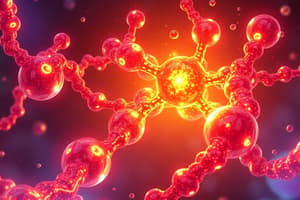Podcast
Questions and Answers
Which glucose transporter is involved in the rapid uptake and release of glucose in the liver and kidneys?
Which glucose transporter is involved in the rapid uptake and release of glucose in the liver and kidneys?
- GLUT-4
- GLUT-1
- GLUT-3
- GLUT-2 (correct)
What is the primary function of GLUT-4 transporter?
What is the primary function of GLUT-4 transporter?
- Absorb sugars from food
- Regulate blood glucose levels in the liver
- Facilitate glucose uptake when blood glucose is elevated (correct)
- Transport glucose in the small intestine
Which tissue types primarily utilize GLUT-4 for glucose transport?
Which tissue types primarily utilize GLUT-4 for glucose transport?
- Brain and pancreas
- Liver and kidneys
- Small intestine and liver
- Heart, skeletal muscles, and adipose tissue (correct)
What dietary restriction is recommended to manage glucose uptake issues in infants?
What dietary restriction is recommended to manage glucose uptake issues in infants?
Which type of glucose transporter is predominantly found in pancreatic B-cells for insulin secretion?
Which type of glucose transporter is predominantly found in pancreatic B-cells for insulin secretion?
What type of glucose transporter is primarily involved in sodium-dependent transport of glucose?
What type of glucose transporter is primarily involved in sodium-dependent transport of glucose?
Which process primarily occurs in the stomach during digestion?
Which process primarily occurs in the stomach during digestion?
What type of transport does SGLT-1 utilize for glucose and galactose absorption?
What type of transport does SGLT-1 utilize for glucose and galactose absorption?
What is a common manifestation of lactose intolerance?
What is a common manifestation of lactose intolerance?
Which of the following sugars is absorbed through the GLUT-5 transporter?
Which of the following sugars is absorbed through the GLUT-5 transporter?
What is the primary consequence of inherited sucrase deficiency?
What is the primary consequence of inherited sucrase deficiency?
What type of bond does salivary amylase act upon in the mouth during digestion?
What type of bond does salivary amylase act upon in the mouth during digestion?
What is the primary goal of biochemistry?
What is the primary goal of biochemistry?
Which of the following are considered macromolecules?
Which of the following are considered macromolecules?
Which carbohydrate is classified as a disaccharide?
Which carbohydrate is classified as a disaccharide?
How do all living cells exhibit biochemical unity?
How do all living cells exhibit biochemical unity?
Which of the following substances is not digested by the human digestive system?
Which of the following substances is not digested by the human digestive system?
What are the monomeric subunits of proteins?
What are the monomeric subunits of proteins?
Which foundational aspect of biochemistry refers to the chemical processes within and related to living organisms?
Which foundational aspect of biochemistry refers to the chemical processes within and related to living organisms?
According to the foundations of biochemistry, what defines the genetic foundation?
According to the foundations of biochemistry, what defines the genetic foundation?
Flashcards are hidden until you start studying
Study Notes
Introduction to Biochemistry
- Biochemistry applies chemistry to study living organisms, their atoms, and molecules.
- Aims to explain biological forms and functions in chemical terms.
- Understanding biochemistry helps in disease prevention, treatment, and functional modifications in cells.
Foundations of Biochemistry
- Cellular Foundations: All living organisms share common chemical features including basic structural units (cells) and monomeric subunits (nucleotides, amino acids).
- Chemical Foundations: Biochemical unity indicates that all organisms share a common evolutionary origin based on universal chemical intermediates.
- Influential Quote: Jacques Monod highlighted the universal truth in Biochemistry: “What is true of E.coli is true of the elephant.”
- Importance: Biochemistry is essential across life sciences such as Physiology, Immunology, Pharmacology, Pathology, and Microbiology.
Macromolecules and Carbohydrates
- Three families of macromolecules include carbohydrates, proteins, and nucleic acids.
- Dietary carbohydrates are classified into Monosaccharides (e.g., glucose, fructose), Disaccharides (e.g., maltose, sucrose), and Polysaccharides (e.g., starch, cellulose).
Digestion and Absorption of Carbohydrates
- Digestion begins in the mouth with salivary amylase acting on α 1-4 glucosidic bonds.
- Stomach digestion includes acid hydrolysis.
- In the small intestine, pancreatic amylase and intestinal disaccharidases facilitate further digestion.
- Absorption of monosaccharides occurs via simple diffusion, facilitated transport (GLUT-5), and co-transport (SGLT-1).
Transport Mechanisms
- SGLT-1: Active transport mechanism for glucose and galactose.
- GLUT-2: Essential for blood glucose regulation, facilitates rapid uptake and release in liver, kidneys, and some intestinal cells, also involved in insulin secretion.
- GLUT-4: Insulin-dependent transporter, found in heart, skeletal muscles, and adipose tissue; responsible for glucose uptake during increased blood glucose levels.
Disorders of Digestion and Absorption
- Lactose Intolerance: Caused by lactase deficiency; symptoms include bloating, diarrhea, and dehydration. Treatment involves avoiding lactose.
- Sucrose Intolerance: Inherited sucrase deficiency leads to symptoms similar to lactose intolerance after introducing sucrose in the diet. Treatment involves avoiding sucrose.
Summary of Glucose Uptake
- Glucose transport occurs through various protein carriers, crucial for maintaining glucose homeostasis.
- Both facilitative and sodium-dependent transporters play significant roles in glucose absorption and uptake across different tissues.
Studying That Suits You
Use AI to generate personalized quizzes and flashcards to suit your learning preferences.




